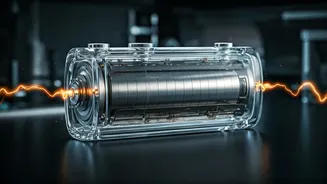Battery Chemistry Explained
Lithium-sulfur (Li-S) batteries are emerging as promising contenders in the realm of energy storage. These batteries have the potential to store significantly
more energy compared to traditional lithium-ion batteries. However, challenges persist, particularly concerning their cycle life and rate performance. One of the critical aspects influencing their efficiency is the intricate chemistry occurring within the battery during charge and discharge cycles. The process involves the movement of lithium ions between the anode and cathode, combined with the conversion of sulfur compounds. Understanding this chemistry is vital for enhancing battery performance. Several studies are actively investigating the factors that limit Li-S battery capabilities, with oxygen trapping emerging as a key area of concern.
Oxygen Trapping’s Impact
A recent scientific study has shed light on how oxygen trapping affects the performance of sodium-ion batteries, which has implications for the overall battery life. Scientists observed that the presence of oxygen within the battery materials can lead to decreased capacity and a shortened lifespan. Specifically, oxygen molecules interact with the active components of the battery, disrupting the electrochemical reactions. This interference hinders the efficient movement of ions and reduces the amount of energy that can be stored and released. The findings suggest that controlling oxygen levels during the battery manufacturing process is critical. The discovery highlights the importance of precise material handling and the need for advanced techniques to prevent oxygen contamination.
Two-Level Strategy Unveiled
To address the challenges posed by oxygen trapping, scientists are developing innovative strategies. A two-level approach is being explored, focusing on both material design and operational optimization. The first level involves employing materials that are more resistant to oxygen interference. This could include the use of coatings or additives to prevent oxygen from interacting with the active components of the battery. The second level focuses on optimizing the operational conditions under which the battery operates. This might entail adjusting the charging and discharging rates, or employing advanced battery management systems to minimize oxygen exposure. Combining these two levels could significantly improve the performance and durability of lithium-sulfur batteries. Further research is underway to refine these strategies, paving the way for more efficient and long-lasting energy storage solutions.
Next-Gen Battery Potential
The advancements in lithium-sulfur battery technology hold immense promise for future energy needs. Li-S batteries are attractive because sulfur is a cheap and abundant element. The development of improved Li-S batteries could revolutionize various sectors, from electric vehicles to grid-scale energy storage. The higher energy density of these batteries could enable longer driving ranges for EVs and increased storage capacity for renewable energy sources. This technology would be more sustainable. As research progresses and the identified issues are overcome, we can expect to see Li-S batteries playing a central role in the energy landscape. Continued exploration into the intricacies of battery chemistry, like the impact of oxygen, will drive innovation and create a cleaner, more efficient energy future.













